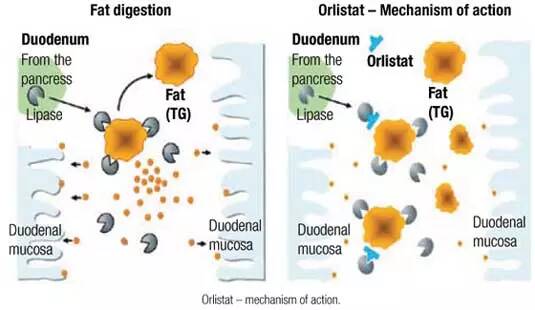Treatment
How does Orlistat work?
When you consume food, enzymes help to break down the food into smaller particles so that it can be absorbed into your bloodstream. The enzymes that breakdown fat are called gastric and pancreatic lipases and they work in the stomach and small intestine. They break down fat into fatty acids and glycerol which can then be absorbed into your bloodstream before being distributed and stored in your body, which causes weight gain.
Orlistat is the name of the medication and the active ingredient which works by blocking the action of gastric and pancreatic lipases and so stops the breakdown of fat into smaller particles. This means that the fat is too large to be absorbed into the bloodstream and so instead simply passes through the body unchanged and is consequently removed in your stools. Dietary fat is high in calories and if these calories can’t be absorbed this in turn leads to weight loss.
Orlistat is intended for adults who have a BMI of 30, or 28 when associated with additional risk factors (such as diabetes, heart disease, high blood pressure or high cholesterol). It is currently the only approved weight loss medication when followed with a low-fat, reduced calorie diet and regular exercise.

How do you take Orlistat?
One Orlistat capsule should be swallowed with water three times a day with each of your meals containing fat. It should be taken either one hour before, during, or one hour after the meal.
It is recommended to skip the capsule if your meal has no fat in it. If your diet is low on fat already you may only need to take one or two capsules a day.
The treatment should be taken for 12 weeks and if you haven’t lost weight after this period, consult your doctor or pharmacist as the treatment may be infective for you and you may need to stop taking it. Read more information about the effectiveness of taking Orlistat.
What can you eat when taking Orlistat?
Whilst taking Orlistat, you should eat a well-balanced healthy diet and make efforts to cut down the amount of fat you consume. It should be taken as a weight loss aid and not the centre of a weight loss regime and still requires eating healthy and exercising regularly to achieve your weight loss goals. A high fat diet when taking Orlistat will increase the risk of unwanted side effects.
What are the side effects of taking Orlistat?
All medications can potentially cause side effects, but this does not mean you will experience them. As Orlistat works by passing fat through your faeces, the most common side effects include:
- Abdominal discomfort
- Oily spotting
- Faecal urgency
- Flatulence
- Fatty/oily stools and increased defecation.
You can reduce the likelihood of experiencing these side effects by reducing your fat intake in your diet.
It is critical that you have realistic achievable goals when taking Orlistat and understand the importance of using it with a balanced nutrient-rich calorie-controlled diet plan and increasing regular exercise.


